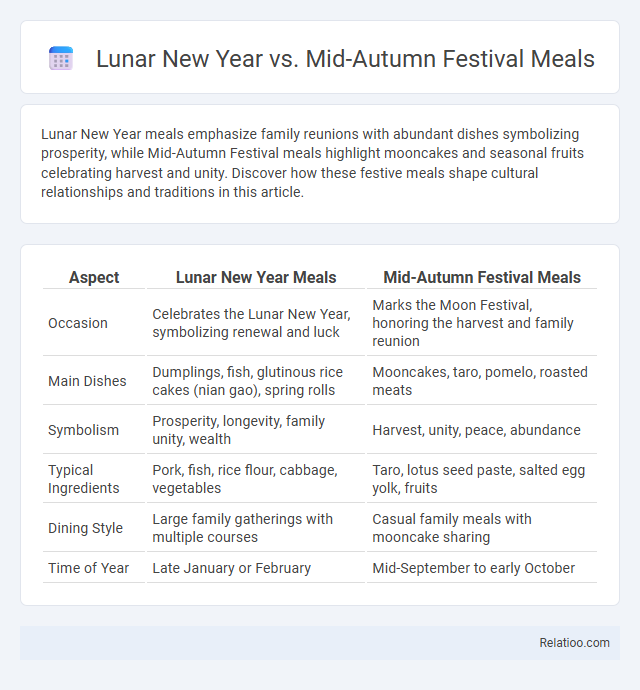Lunar New Year meals emphasize family reunions with abundant dishes symbolizing prosperity, while Mid-Autumn Festival meals highlight mooncakes and seasonal fruits celebrating harvest and unity. Discover how these festive meals shape cultural relationships and traditions in this article.
Table of Comparison
| Aspect | Lunar New Year Meals | Mid-Autumn Festival Meals |
|---|---|---|
| Occasion | Celebrates the Lunar New Year, symbolizing renewal and luck | Marks the Moon Festival, honoring the harvest and family reunion |
| Main Dishes | Dumplings, fish, glutinous rice cakes (nian gao), spring rolls | Mooncakes, taro, pomelo, roasted meats |
| Symbolism | Prosperity, longevity, family unity, wealth | Harvest, unity, peace, abundance |
| Typical Ingredients | Pork, fish, rice flour, cabbage, vegetables | Taro, lotus seed paste, salted egg yolk, fruits |
| Dining Style | Large family gatherings with multiple courses | Casual family meals with mooncake sharing |
| Time of Year | Late January or February | Mid-September to early October |
Introduction: Comparing Lunar New Year and Mid-Autumn Festival Meals
Lunar New Year meals emphasize dishes symbolizing prosperity and luck, such as dumplings, fish, and sticky rice cakes, while Mid-Autumn Festival meals center around mooncakes and seasonal fruits that celebrate reunion and harvest. Both festivals feature traditional recipes deeply rooted in cultural heritage, showcasing diverse cooking techniques and regional flavors. These meals serve as culinary expressions of important cultural values, marking the distinct yet complementary significance of each celebration.
Historical Significance of Festival Feasts
Lunar New Year meals symbolize renewal and prosperity, featuring dishes like dumplings and fish that represent wealth and abundance, deeply rooted in centuries-old traditions. Mid-Autumn Festival feasts center around mooncakes and seasonal fruits, embodying unity and gratitude while honoring the moon's historical significance in Chinese culture. Your understanding of these festival feasts highlights the rich heritage and cultural values preserved through their distinct culinary customs.
Core Dishes of Lunar New Year Celebrations
Core dishes of Lunar New Year celebrations typically include dumplings, symbolizing wealth, and fish, which represents abundance and prosperity for the coming year. Unlike the Mid-Autumn Festival, where mooncakes play a central role, Lunar New Year meals emphasize dishes like niangao (glutinous rice cake) and spring rolls, each carrying traditional meanings of growth and wealth. Your preparation of these festive dishes not only honors cultural heritage but also brings families together to share blessings and hopes for a prosperous year.
Iconic Foods of the Mid-Autumn Festival
Iconic foods of the Mid-Autumn Festival include mooncakes, which symbolize reunion and are filled with sweet lotus seed paste or salted egg yolk, embodying rich cultural traditions. Unlike the varied dishes served during Lunar New Year meals, Mid-Autumn Festival cooking centers on these delicate pastries alongside pomelo and taro, which represent prosperity and good fortune. Your festive table will be enriched by these symbolic treats that highlight the festival's emphasis on family unity and gratitude.
Symbolism Behind Festival Ingredients
Lunar New Year meals feature ingredients like fish for prosperity, dumplings shaped like ancient gold ingots symbolizing wealth, and sticky rice cakes representing growth and progress. Mid-Autumn Festival dishes highlight mooncakes, which embody unity and completeness through their round shape and fillings symbolizing harmony. Both festivals use specific foods that reflect cultural values, prosperity, and familial bonds, deeply rooted in traditional symbolism.
Regional Variations in Festive Menus
Lunar New Year meals vary significantly by region, with northern China favoring dumplings and southern China emphasizing glutinous rice cakes like nian gao, symbolizing prosperity and unity. Mid-Autumn Festival menus focus on mooncakes, which differ in fillings such as lotus seed paste in eastern China and salted egg yolk in southern provinces, reflecting local tastes and traditions. Regional cooking techniques influence festive dishes, with steaming preferred in the south for delicate flavors, while northern regions often use boiling and frying to create heartier textures.
Sweet Treats: Mooncakes vs. New Year Desserts
Mooncakes are the iconic sweet treat of the Mid-Autumn Festival, featuring rich fillings like lotus seed paste, red bean, or salted egg yolk, symbolizing unity and prosperity. Lunar New Year desserts vary widely but often include glutinous rice cakes (nian gao) and sweet rice balls (tangyuan), both representing reunion and good fortune. Your celebration can be enriched by choosing mooncakes for Mid-Autumn festivities or traditional New Year sweets to honor cultural heritage and bring sweetness to family gatherings.
Rituals and Traditions at the Dining Table
Lunar New Year meals emphasize reunion and prosperity, featuring symbolic dishes like dumplings, fish, and rice cakes that represent wealth, abundance, and unity shared in a family-oriented feast. Mid-Autumn Festival meals center around mooncakes and seasonal fruits, with rituals focusing on moon worship and expressing gratitude, often enjoyed outdoors under the full moon. Both festivals highlight communal dining as a sacred ritual, reinforcing cultural values through specific foods and ceremonial customs passed down through generations.
Modern Influences on Festival Meals
Modern influences on Lunar New Year and Mid-Autumn Festival meals reflect a blend of traditional flavors with contemporary culinary techniques, incorporating global ingredients and innovative presentations. Your festival cooking now often features fusion dishes that maintain symbolic meanings while appealing to diverse tastes, such as vegan dumplings for Lunar New Year or flavored mooncakes infused with matcha or chocolate. Food delivery services and social media trends also shape how these festive meals are prepared and shared, enhancing convenience and creativity in celebration.
Conclusion: Culinary Connection of Both Festivals
Lunar New Year and Mid-Autumn Festival meals both emphasize communal harmony through dishes symbolizing prosperity and unity, such as dumplings for wealth during Lunar New Year and mooncakes representing reunion in the Mid-Autumn Festival. Cooking methods for both festivals often highlight traditional techniques like steaming and baking to preserve flavor and authenticity, reinforcing cultural heritage. The culinary connection between these festivals reflects a shared emphasis on family togetherness and the celebration of seasonal cycles in Chinese culture.

Infographic: Lunar New Year vs Mid-Autumn Festival Meals
 relatioo.com
relatioo.com